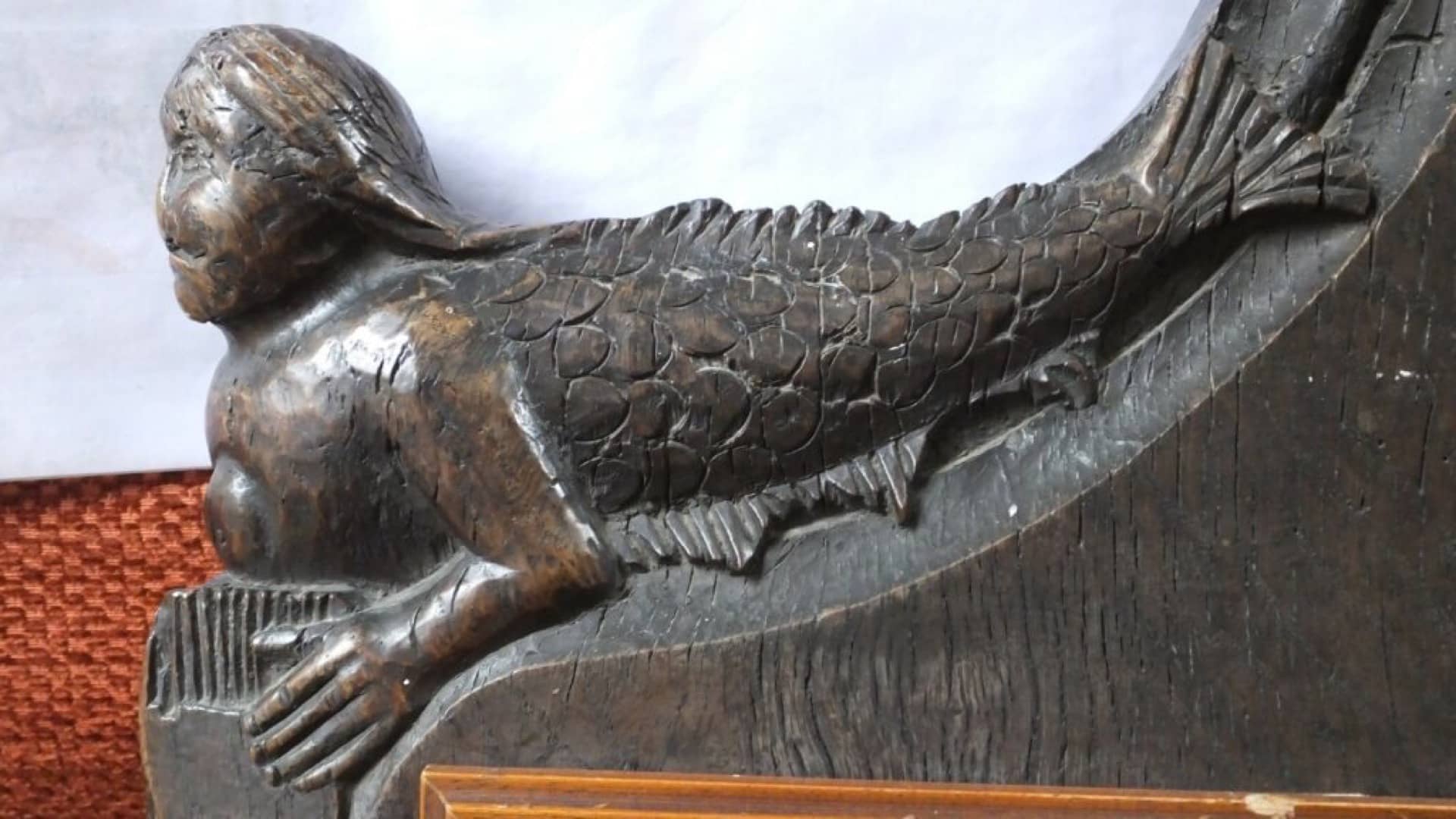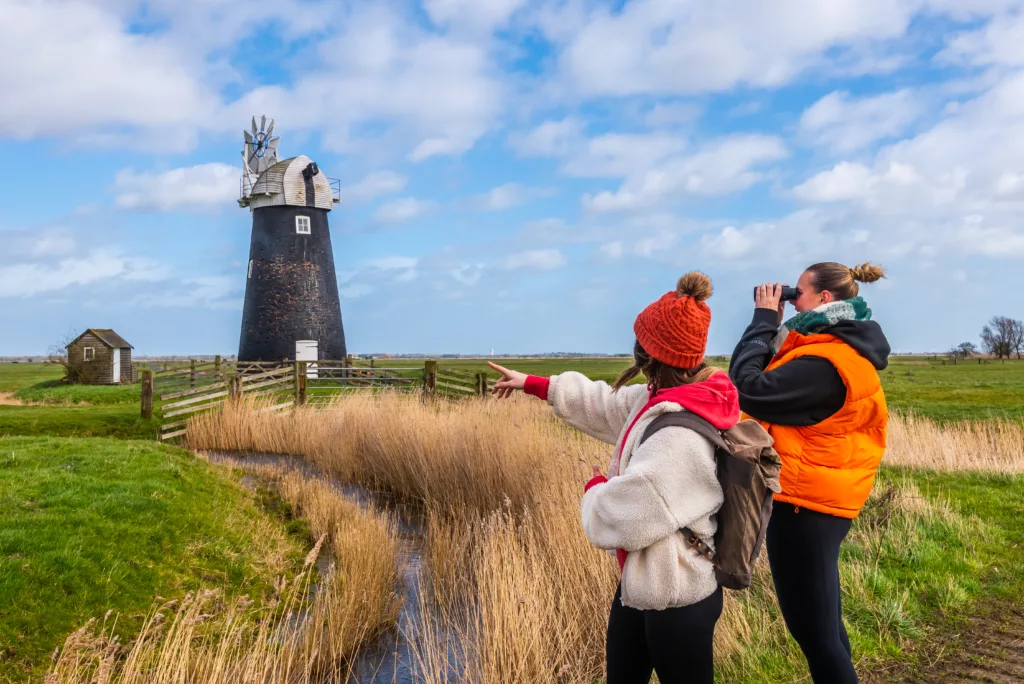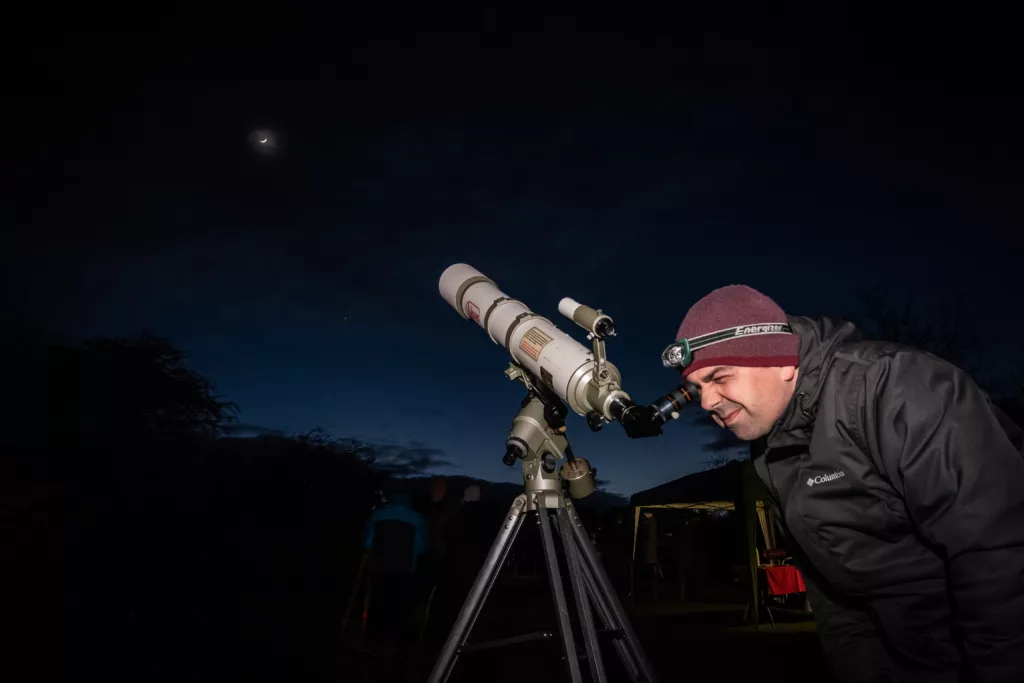
Chalk and Fossils
Famed for vast beaches and wild saltmarsh, Norfolk has an amazing coastline including a rocky cragwhich is striped like a circus tent.
Hunstanton cliff’s eye-catching bands of red, white and burnt orange sedimentary rock featured in the film ‘Spencer’ (2021). The colours are a joy for photographers, capturing their glowing beauty from this west-facing shore, especially dramatic during stormy sunsets.
A Site of Special Scientific Interest, the stunning stripy cliffs are part of a sweeping chalk ridge that once extended from the Chilterns to Yorkshire. In a fast-paced world, it’s calming to experience their slow majesty, knowing those ancient chalk layers accumulated at the steady rate of one foot every 30,000 years.
Chalk is the remains of organisms which once swam in the warm, tropical Cretaceous sea that covered Norfolk between 135 and 70 million years ago. The bottom layer of red brown carrstone is considered to be c.108 million years old and above it is a broad stratum of red chalk coloured by iron pigments and rich in fossils. Fossil hunters may find coccoliths, bivalves, belemnites and even shark’s teeth. But be careful! The cliffs are fragile and coastal erosion causes large chunks to fall quickly, so walk well clear of their shadow and stay safe.
And if rock fans think these cliffs look familiar, check your Stranglers albums. The punk band used Hunstanton cliffs as the location for the cover shoot of their aptly named ‘Norfolk Coast’ album. It’s official. Hunstanton rocks.

Ringstead Downs
Ringstead is easy to miss. And that would be a great shame, for this little village is full of character, tucked away from the busy Norfolk coast near the seaside town of Hunstanton.
Its pretty white-washed 17th century coaching inn, The Gin Trap, is an award-winning, dog-friendly pub with immaculate cosy rooms. Famed for fantastic local produce washed down by hearty local ales and gins, the pub’s name doesn’t actually come from a delectable G&T. It’s refers to the fearsome metal jawed trap once used to snare animals. Thankfully these brutal traps have long since been banned. Phew!
The Gin Trap is very close to Ringstead Downs, a Norfolk Wildlife Trust Reserve.
This 6.9-hectare (17 acre) wooded valley is a Site of Special Scientific Interest, where chalk stone was carved out by glacial meltwaters when the last Ice Age receded. The valley has never been ploughed, so it’s incredibly rich in biological diversity and is now the largest surviving area of chalk downland in the county. Signs guide you to a secret chalk pit conservation area. Many local roads are named Chalk Pit Lane, testament to the former local industry.
In autumn Ringstead Downs are sprinkled with starry purple gentians and bush crickets sing to the year’s last warmth before winter reveals the valley’s unique architecture. Skeletal trees cling to the steep sides and high in the clear air, red kites wheel and the buzzard’s plaintive cry evokes Norfolk’s ancient wild spirit.

Hunstanton Observatory
West Norfolk is one of the incredibly lucky places in the UK to be ideal for star gazing, with it’s wide-open skies, natural landscape and tranquillity.
Hunstanton Observatory provides a venue for observation of the night sky using telescopes and binoculars, and for astrophotography, the practice of photographing objects in the night sky. The Observatory will also provide a venue for other night-time activities such as nocturnal wildlife observation, as well as daytime activities such as solar astronomy (observing and photographing the Sun), wildlife watching, educational events and classes, and environmental awareness events.
The astronomical observatory building itself features a rolling roof, whereby the entire roof of
the building is able to be rolled away to reveal the stunning open skies above. The observatory also includes a visitor interpretation panel, two bicycle stands, and associated landscaping.
The Observatory has been designed to assimilate into its surrounding context, stylistically reflecting the nearby beach huts of Old Hunstanton beach. The Observatory helps to bring people together and encourage interaction between local people and tourists alike, providing opportunities for education and a general-purpose facility for the local community.
The site is easily accessible by bus from either the Lighthouse Close bus stop or the Post Office bus stop on Old Hunstanton Road and perfect to access via bicycle, with racks provided.

Sheringham Mermaid
On a sandbank off Sheringham, a mermaid sang to the wandering stars, forlorn and all alone. One winter night it seemed her searching voice heard an answering call. Echoing through the streets came the sweet sound of human voices raised in harmony amid cascading peals of church bells. Enchanted, she hauled herself onto the pebble beach. Her silvery fish’s tail was cumbersome in the cold air, but the singing was so beautiful she dragged her body inch by inch over the rough streets and into the church.
But these were fishing folk and mermaids are unpredictable creatures, agents of both fortune and disaster, changeable as the sea. Besides, they have no immortal soul. So the people were afraid and cast her out.
When they’d gone, she crept back into the church. And she’s there still. At All Saints in Upper Sheringham you’ll find a mermaid carved into the end of a 15th century pew. Perhaps angels took pity on the sea nymph’s lonely heart and, as wooden figureheads guide ships to harbour, they brought her safely home.
If you want to be sure of getting home safely, listen for the Yow Yows. That’s Sheringham’s term for a sudden squall, named after uncanny sounds shifting across the waves before storms strike. Some say it’s the drowned voice of an old sea captain still cursing local fishermen who let him perish. If you hear cries of eternal distress, return immediately to shore, for his warning is an omen of doom

Steam Train Rover Ticket Experience
If you’re a fan of The Railway Children, roll back the years and explore the North Norfolk countryside by steam train. Chug through delightful open countryside and pretty woodland, past glorious coastal vistas and into friendly little towns where stepping onto the historic station platform feels like travelling in time. Pootle round the smart Victorian seaside resort of Sheringham, then go on to elegant Holt, a handsome Georgian market town. Or jump off at Weybourne for a bracing march down to the pebble beach where The Personal History of David Copperfield starring Dev Patel and Hugh Laurie was filmed. The North Norfolk Railway runs through the county’s most stunning scenery so get your camera ready, or settle back and enjoy the rhythm of the railway.
Enjoy an 11-mile round trip on board an historic steam engine or heritage diesel train, or make a beautiful day of it with a great value Rover ticket, valid for unlimited travel allowing you to hop on and off all day. If you feel like a walk over breezy heathland or strolling in the autumn woods, just get off the train and go for a wander. You can just catch another later, when you’re feeling peckish or fancy a pint. The heritage railway is fondly known as the ‘Poppy Line’ because 19th Century poet and theatre critic Clement Scott coined the term ‘Poppyland’ for the unspoilt coastal stretch around Sheringham where masses of scarlet poppies begin to appear from late spring.

Kelling Heath Holiday Park: Dark Skies and Dorhawks
Once a vast glacier retreated under glittering stars. Over 400,000 years later, the same stars shine on, but the landscape left by the glacier is largely lost, except at unique sites like Kelling Heath Holiday Park.
Paths weave through a magical tapestry of ancient woodland, conifers, swaying grasses, and tussocky heathland, scented by heather and peachy gorse. The late spring dusk churrs with the rare sound of Dorhawks, a Norfolk name for nightjars, so called because they feast on the Dor or cockchafer beetle. Strange, bewhiskered, spectral birds, their uncanny call haunts starry summer nights.
Kelling Heath is officially a Dark Skies Discovery site, one of the best places in England to see the stars. Free of light pollution, it’s a designated ‘two star’ site, where the seven stars of Orion and the Milky Way, a river of light made from millions of stars, are visible to the naked eye. UK astronomers organise twice yearly star parties, attracting hundreds of astronomers from all over the country, with the September event thought to be the largest star party in Europe.
But you don’t have to be an expert to marvel at breathtaking celestial views. Campers and visitors can just walk outside. Look up. Dazzling star-fields open before you. Search the dark rifts for huge interstellar dust clouds and elusive galaxies you’ll never have seen before.
Low light pollution is integral to the Kelling’s philosophy, so bring a torch as paths are intentionally dark, giving you crystal clear views of our planetary neighbours.

Norfolk’s Great Chalk Reef
Not all reefs are made of coral! A stone’s throw from the Norfolk shore, just under water, is the largest chalk reef in Europe, possibly the world.
The Cromer Shoals Chalk Bed was formed 100 million years ago when dinosaurs roamed the earth. Shaped by meltwater at the end of the last Ice Age it’s 20 miles long, 6 miles wide and teeming with life. Stretching from Weybourne to Happisburgh, the reef is home to over 350 different species of plants and animals, some found nowhere else in the world. It’s significance as one of the England’s most ecologically important marine habitats was recognised in 2016 when the reef was designated a Marine Conservation Zone (MCZ).
Norfolk’s remarkable reef is home to edible and velvet crabs, lobsters, starfish, jellyfish and some fabulously unusual creatures such as the Atlantic ancula sea slug, leopard spotted goby (a shy fish) and strawberry anemone (scarlet with tiny green spots).
On a winter beach walk when the tide’s out you’ll see chalky hollows studded with flint, where rock pools provide a safe haven for winkles, limpets and strange dark red jelly-like blobs. These are beadlet anemones, gorgeously jewel coloured, highly territorial sea-creatures whose soft bodies conceal short tentacles with a potent sting.
To experience the full expanse of the chalk reef you need calm seas, low tides and an elevated position. There’s a great vantage point on Skelding Hill, reached by walking north from Sheringham towards Weybourne on the cliff top coastal path.

Walking Through Time
Walkers love Norfolk’s stunning coastal paths. If you’re one of them, you’ll be following in the footsteps of people who’ve walked here for hundreds of thousands of years.
In fact, actual footprints were discovered at Happisburgh, left in the ancient estuary mud by people roaming this land before the Ice Age. Over 850,000 old, it’s possible they were made by nomadic hunters, following migratory animals such as mammoths, bison, rhinos and deer in the days when Britain was connected to mainland Europe by a great plain, similar to East Africa’s Serengeti. Or perhaps searching the mudflats for seaweed and shellfish.
Amongst the earliest evidence of humans in Britain, these amazing footprints were found accidently during a geophysics survey in 2013. Around 50 footprints were discovered, two showing details of toes. Approximately five individuals were identified, both adults and children. Their footprints were carefully photographed in 3D before being washed away forever by the tides of the North Sea, lost deep in time.
The course of the river where our ancestors once walked has now moved south and is today known as the Thames. Standing on the flint shingle banks, imagine the rolling waves as a vast flowing grassland of creeks and scrub allowing direct passage from Norfolk all the way to Africa.
Close your eyes and listen intently. The hyena and bison have long gone, but sometimes the sea sounds like swishing grass and wind like the mournful trumpet call of a mammoth.

Land of the Windmills
Discover a land of windmills, a flat and wet world of wildfowl, swans, and geese. A place of solitude and escape. Dykes full of blowing reedmace cut across this exposed world, highways for creatures who subterfuge and cover is essential for survival. In winter, wildfowl nibble grass on these expansive grazing marshes. In summer, livestock munch the rich vegetation while swallows catch flies disturbed by trampling hooves.
The vast, open triangular space known as the Halvergate Marshes was an estuary in the Roman period. The town of Great Yarmouth grew up on a sand spit which formed across the mouth of the Estuary. Only Breydon Water survives as a relict part of this once large estuary, the remainder transitioned, initially to salt marsh and later to drained marshland.
People have been living on the marshes for around 1000 years, initially for sheep grazing and salt working. If you look carefully, you can still see a series of mounds or hills on the marshes, which are the spoils dumped by those early salt workers. The word salary is derived from the word salt, which was the currency of the day. Many marsh farms were established on the higher ground formed by the spoil from the salt workings.
By the eighteenth century, an increased number of drainage schemes created conditions suitable for cattle grazing. These cattle were sometimes brought great distances on the hoof from Scotland and Ireland.
The drainage schemes led to the introduction of a large number of drainage windmills, the greatest concentration outside the Netherlands. Many of these survive, often in a semi-derelict state.
The Halvergate Fleet, which runs across the middle of the marshes is a relict watercourse. The original road to Great Yarmouth, the Stone Road, ran alongside The Fleet prior to the construction of the Acle New Road, ‘the Acle Straight’ in the early 1830s.
As well as the Weavers’ Way and Wherryman’s Way long distance paths, two railway lines also cross the marshes but despite these various routes and proximity to Great Yarmouth, the marshes remain a vast remote expanse.

Salhouse Broad Dark Skies Discovery Hub
The Norfolk Broads at night is a perfect place to gaze into the night sky, the wet expanse of reed and broad and being a national park keeps the skies dark. The Dark Skies Hub & area is ideal for stargazing providing a unique way to experience the Broads National Park and Salhouse Broad. The Hub provides an accessible space for you to rest and observe the solar system from a specially built platform. Not only does the Hub offer a stargazing location but gives the opportunity to be amongst some of the rarest wildlife in the UK.
The hub is a place for reflection and information during the day and transforms in the evening into a stargazing site for special events, group visits and the community. Enjoy being close to nature and make the most of Autumn, winter and spring. Soak yourself in the immensity of the night sky and escape from light pollution.
Enrich your understanding about the Broads National Park area, stargazing information, and local daytime & nocturnal wildlife. While here take advantage of everything Salhouse Broad has to offer, including camping, canoe hire, refreshments, and wildlife walks. Salhouse Broad also provides access to the Hoveton Great Broad, which is one of the Broad’s largest lakes.
Build your own itinerary
If you fancy creating your own itinerary for a day trip to Norfolk or a longer visit, it couldn’t be simpler. Just go to Search Activities and select from our wide range of free and paid-for experiences, saving any that capture your imagination with the click of a button.
Once you’ve finished, you’ll find all the information stored in My Favourite, where you can drag and drop activities to create your own day-by-day itinerary! You can download this to a calendar and even share it with friends.
